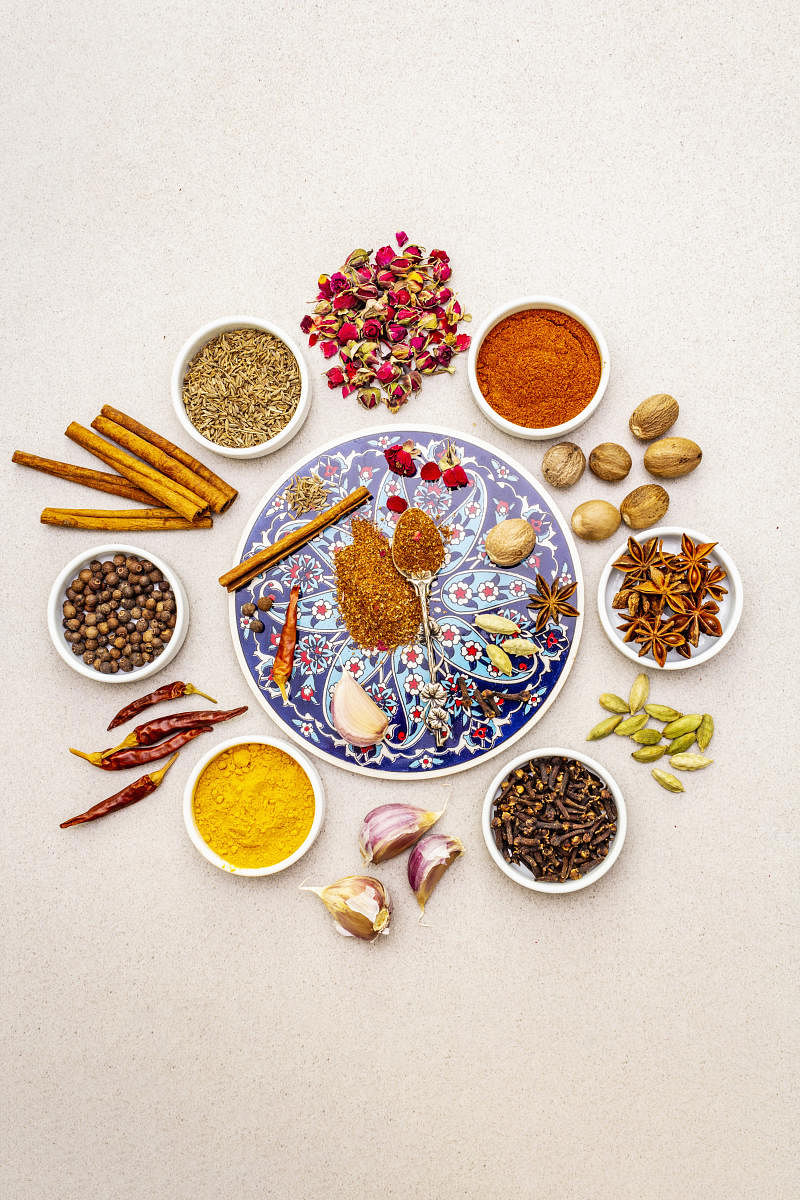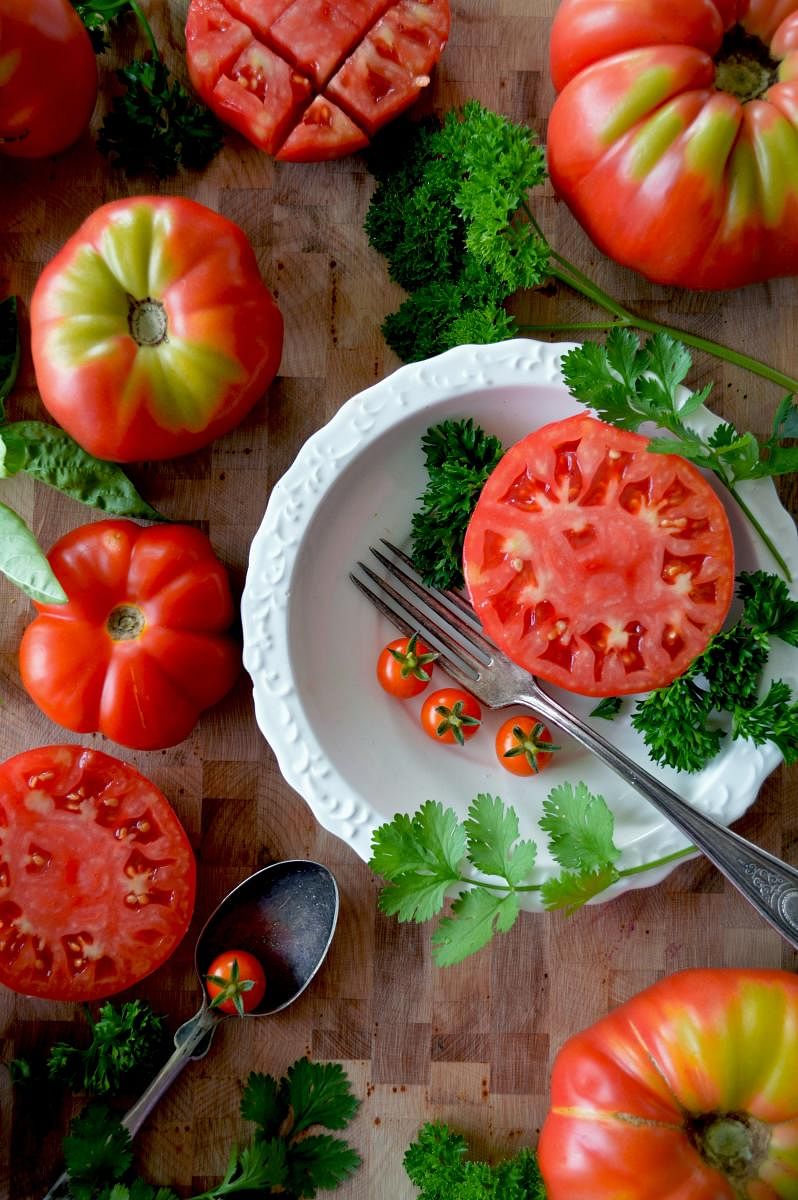

A visit to the vegetable market often ends up with the vendor throwing in a bunch of coriander leaves and chillies. A decade ago, it was for free as a goodwill gesture, now it is to round off the bill. Could one really conceive that this extra dhania patta or feathery coriander leaves that we casually chuck into every Indian dish as a garnish, or, its seeds used whole or liberally dusted as dhania powder to spice up curries and fries, is actually not native to our country?
Although it has been in use in India since ancient times, coriander (Coriandrum Sativum), known variously as cilantro or Chinese parsley, is believed to have originated in Italy and regions around the Mediterranean Sea and the Middle East. Records trace its history as far back as 5000 BC with archaeological evidence of coriander seeds found buried in Egyptian King Tut’s tomb and mentions in ancient Egyptian texts and in the Old Testament in Exodus 16:31! It features in the ancient recipes for stews inscribed in the Akkadian script on clay tablets discovered in Mesopotamia.
Heavily documented by early Romans, Greek scholars and physicians like Hippocrates and Pliny who hailed its benefits in treating digestive, respiratory and urinary disorders, the humble coriander has earned quite a reputation in cuisines across the world including Latin America, Europe, China and Scandinavia besides India. Pliny noted that the highest quality of coriander found in Italy was grown in Egypt! While coriander and cilantro are used almost synonymously, coriander usually refers to the seeds while cilantro is the herb or leaves of the plant.
The strong taste and aroma of its stalks and leaves inspired its rather uncomplimentary etymology. The Latin word for coriander ‘coriandrum’ is derived from Greek koros meaning insect or koriannon or stink bug, which
emanates a similar acrid, fetid smell when squashed. Notwithstanding its infamy as the ‘stinking herb’, coriander has managed to stay relevant thanks to its distinct flavour profile — one that imparts an earthy, lemony tanginess to food that finds appeal across the globe.
A key ingredient
Coriander is known by several names across cultures — kisnis in Western Turkic, geshniz in Farsi or Persian, kinj in Armenian, kuzbarah in Arabic, kissburu in Akkadian, kustumbari in Sanskrit, kothambari in Kannada, kothimbir in Marathi and kothamir in Gujarati and Urdu. Its popular name dhaniya refers to its ‘dhani’ colour like fresh paddy, though some equate its benefits with dhan (wealth).
Coriander leaves were referred to as ‘cilantro’ in Spain and it was the Spanish conquistadors who introduced the herb in Central, South and Latin America. Today, cilantro is a key ingredient in Mexican and Peruvian dishes and soups. Since Roman times when they flavoured bread with coriander to its use in sausages, salsa and pesto, gravies, pastries, liqueurs, confectionery and even cocktails, man has put every little part of this versatile annual plant to use in a variety of ways.
Coriander or cilantro leaves, seeds, flowers and roots have been used to flavour rice, soups, stews, sausages, and ratatouille, in pickles and baked dishes and Belgian wheat beer. Its globular fruit is a dry schizocarp, which yields
two locules, each containing a highly aromatic tawny pod-like ribbed seed used as spice. When used whole, crushed or powdered, coriander seeds infuse a unique blend of nutty to citrusy, herby notes. The seeds are usually toasted to draw out its distinct notes before being ground into a powder. From garam masalas to curries, coriander seeds are used to prepare Ethiopian berbere, Moroccan ras el hanout, Arabic baharat mixes and Yemeni zhoug while the leaves feature extensively in Thai green curry paste and Mexican moles.
Aromatic or offensive?
While some find the aroma of coriander heavenly and inviting (to the Hebrews, it is likened to manna in the Book of Numbers) others contend its offensive odour is comparable to detergent or burnt rubber! Funnily, during medieval times and the Renaissance era, coriander was regarded as an aphrodisiac and added to love potions. Wine with coriander apparently incited ‘animal passions’.
The art of preserving meat in Britain using cumin and vinegar with coriander is attributed to the influence of the late Bronze Age invaders who flavoured their barley gruel with coriander.
Cultivated in China since the 4th Century, today coriander is grown and consumed widely across the world from cold regions like the Netherlands, Europe to hotter climes of Mediterranean and North African countries, India and Bangladesh and far away Central and South America, Russia and the USA. Easy to grow in a
garden patch or pot, the tender plant bears small whitish to pale pink flowers in umbel clusters with the delicate look of a lacy doily.
Rich medicinal benefits
As one of the oldest spices used by mankind, coriander was held in great esteem for its medicinal and health-related properties. Coriander leaves and seeds hold a wealth of vitamins, minerals and essential oils and are a rich source of vitamin C, vitamin A and vitamin K, thiamine, iron, manganese, zinc, calcium, potassium, sodium, magnesium and phosphorus. The Greeks used coriander for weight loss while Ayurveda prescribed coriander as digestive support while its cooling property provides a great remedy for urinary disorders.
Chinese medicine used the herb to treat problems as far-ranging as nausea, flatulence, hernia and piles to measles and toothache! Aromatherapy adopts coriander to aid digestive disorders and circulation, eliminate toxins, and treat rheumatism and arthritis. But only a handful knew that coriander was one of the magic ingredients used to flavour liqueurs such as Chartreuse and Benedictine.
Interestingly, a unique variety of dhania we encountered on our travels is culantro (not to be confused with cilantro) or Mexican coriander (Eryngium foetidum). Originally from the carrot family, the plant is native to Central and South America, besides the Caribbean where it’s called shadow benny, a corruption of chadon beni, derived from the French chardon (herb) and beni (blessed). The Chinese introduced the herb to South East Asia as a substitute for coriander. In the North East, it’s known as Naga dhania or Burma dhania.
Its long leaves grow in rosettes and are serrated; hence its popular name long coriander or saw tooth coriander. It is considered ten times as potent and flavourful as regular coriander and is widely used in cuisine and medicine.
(The authors are travel/food writers and culinary consultants “loosely based” in Bengaluru. They run a travel/media outfit customising solutions for the hospitality industry, have authored guides and coffee table books, set up an award-winning restaurant and feature as ‘Dude aur Deewani’ in a new food-based digital infotainment show. Follow their adventures on Instagram: @red_scarab or their Facebook page Red Scarab.)